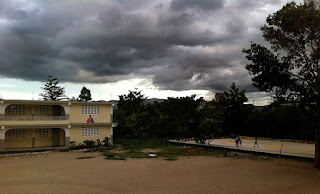 |
| Midwifery students and their teacher, Marthonie |
Nou La is we are here.
Tomorrow is our last day in Hinche. I feel like the time has
flown by. I feel like I haven’t posted enough. I feel less of an observer,
recorder than the two previous visits. We are in the groove with life in
Hinche—St. Therese at night, the orphanage during the day; bumpy rides in the
pink jeep, halting Kreyol that makes me feel like I am tripping over myself
when I open my mouth. Dina says this is not true and she is impressed that I am
speaking in “paragraphs.” Dina tells jokes in Kreyol, so we are even.
The first two births of last night’s shift came within 15
minutes of our arrival. Two healthy babies. Then, I slept. Earlier in the day,
I had travelled to Port Au Prince with Genette, the young and inspired clinical
director who I am trying to bring to the MANA conference. We left Hinche at 4am
to arrive in Port Au Prince by 6:30. We went to the US embassy to try to get
her passport. It is always by appointment only at the embassy. Even so, there
is a long line that you need to wait in. I had come along, hoping that I could
speak on her behalf and confirm her reasons for travel. But, I didn’t have an
appointment. Either did Genette. Her appointment had been last Friday, the day
that the “hurricane” was supposed to pass through. The day they closed the
embassy. She had heard on the radio that all those with Friday appointments
needed to arrive on Wednesday for their rescheduled appointment.
I worked my way up the line for Americans and simply told
them that I had had an appointment on Friday that was cancelled and that was
why I didn’t have an appointment for today. They let me through the security
gate and I passed onto American soil.
The American embassy is a solid-looking structure compared
to all the other cement and rebar buildings in Haiti. It looked like the
outside was granite and the doors were heavy glass. Inside it was
air-conditioned, clean and electronic. Each person hoping for a visa needs to
get in line to speak with one of the cashiers. The cashiers sit on the other
side of a glass window and speak to you through an intercom. It is here that I
learned that today’s rescheduled visits were only for Immigrant visas – not the
kind we were looking for for Genette.
I told the cashier my story: that we had come a long way;
that I am leaving on Saturday; that I want to be here for the appointment.
Isn’t there some way that she can be seen today? No. You will need to send us
an email to try to expedite her appointment. But who receives those emails?
Can’t I just talk to them today? No. You will need to send an email. Can I
speak to a supervisor? Oh, you were supposed to have an appointment on Friday,
the day of the hurricane? Then, you will need to send an email. You see where
this was going.
Strike one. Not out yet though. Genette never even made it
through the security gate. To take advantage of our trip to PAP, I asked Genette’s
brother Gito, who had driven us to PAP, if he could show me the Neg Mawon. It
is a famous statue outside of the President’s palace in Petionville. The Neg
Mawon symbolizes the freed slave who was now marooned on this tropical island.
It is a symbol of strength and commitment for the Haiti people.
I also saw the damaged presidential palace.
After a small bite to eat, we headed home. When I arrived
back at Maison Fortune, I sent an email.
Needless to say, I was tired that night, and, after our
first two births, I slept for 4 hours. Soon after I woke up, a woman came in
with a small hand peaking out of her vagina. This was not good news in any way.
She was only 30 weeks pregnant, dangerously premature. The baby was thought to
be in a transverse position, but as the baby began it’s descent to be born, the
hand retreated and a small rump appeared. The staff midwife and the students
could not find a heart beat, so the baby was presumed dead.
With a stillbirth in a breech position, the students know
that the best thing is patience and to let the birth proceed at it’s own pace. The
baby’s limp and lifeless body slowly emerged. There is always a point in a
breech birth that looks odd because the body is out and the head is still
inside the mother. With a complete lack of muscle tone, the baby’s body slowly
crumpled in a small heap as we waited for the head to be born. Then, a small
convulsion of the baby’s body. Was that for real? Is this baby alive and
fighting for life? It happened again. Yes, this was a faint sign of life in a
baby that we thought was no longer living. But truly, this movement was only a
reflexive action of the baby’s nervous system. There was no muscle tone, no
reflexes, when the baby was finally born, no breathing effort.
So here was the flip side of the coin of our experience with
the baby, Miracle. Was this baby in need of a massive resuscitation effort that
couldn’t be sustained and that would ultimately not save the baby’s life? Was a
day or two of living worth the effort? This baby was unresponsive, not
breathing, unconscious, but had a slow heartbeat. Without words, we all knew
that this baby wouldn’t make it. It was too early, too difficult a delivery, too
far gone. We were the ones who had to suffer through the 20 minutes of its
short life. Who gets to decide who lives and dies? Is a massive, heroic
American effort to resuscitate a baby the right thing to do when there is
absolutely no ongoing care here for premies? Even if the baby were to live, the
risk of brain damage is great. Is it fair to ask an already impoverished family
to take on child that will always be a burden? The answers are impossible to know,
so instead you go with your gut. For me, I knew that this baby wouldn’t make it
and that instead, it might be better to have the mother just hold the baby for
the few minutes of its life. Except in Haiti, most mothers don’t even look at
their babies that are born healthy and alive. The mother declined the offer to
hold her baby.
We wrapped the baby in a small, blue surgical towel, giving
some semblance of comfort. The baby lived for 20 minutes and never made a
breathing effort except for its spasmodic, occasional agonal breaths. Later,
the mother stood in her white mesh “culotte,” unsure of the next steps when you
are leaving the maternity ward empty handed. It was her first baby.
The next, and final, baby of the night was born healthy, if
not full of drama. The mother was reluctant to open her legs and was quite loud
in her travail. The mother’s name is Darling and she named her baby girl,
Guerline. She smiled when I asked to take a photo of her and her baby. A moment
of pride.































